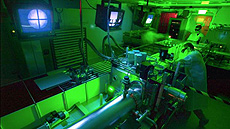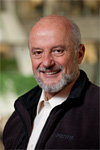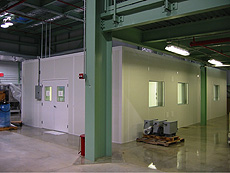|
Have a safe day!
Tuesday, Oct. 30
3:30 p.m.
DIRECTOR'S COFFEE BREAK - 2nd Flr X-Over
THERE WILL BE NO ACCELERATOR PHYSICS AND TECHNOLOGY SEMINAR TODAY
Wednesday, Oct. 31
3:30 p.m.
DIRECTOR'S COFFEE BREAK - 2nd Flr X-Over
4 p.m.
Fermilab Colloquium - One West
Speaker: Lauren Hsu, Fermilab
Title: Dark Matter: The Next Great Discovery of Particle Physics?
Click here for NALCAL,
a weekly calendar with links to additional information.
Ongoing and upcoming conferences at Fermilab
|
|
Tuesday, Oct. 30
- Breakfast: All-American breakfast
- Tomato florentine soup
- Twin chili cheese dogs
- Chicken cacciatore
- Smart cuisine: Mediterranean baked tilapia
- Rachel melt panini
- Personal pizza
- Chicken BLT salad
Wilson Hall Cafe Menu
|
|
Wednesday, Oct. 31
Lunch
- Skeleton bones
- Frankenstein fingers
- Ghost clouds
- Dracula's dream
Friday, Nov. 2
Dinner
- French onion soup
- Grilled swordfish with white wine
- Butter sauce with capers
- Corn risotto
- Sautéed pea pods with red peppers
- Almond cake
Chez Leon Menu
Call x3524 to make your reservation.
|
|
Dark Energy Camera all-hands celebration - today
Everyone is invited to attend an all-hands celebration today at 9:30 a.m. in Ramsey Auditorium. Learn about the world's most powerful digital camera, which began capturing and recording images in September.
The celebration begins with a non-technical overview from 9:30 to 9:45 a.m. led by Fermilab scientist and project manager Brenna Flaugher. A 15-minute question-and-answer session will follow from 9:45 to 10 a.m. After the all-hands meeting, coffee and bagels will be provided in the Wilson Hall cafeteria. Fermilab scientists will be present to answer questions about the Dark Energy Camera.
Managers and supervisors: If at all possible, please encourage your staff to attend.
|
Fermilab director search committee members named
The next step has been taken in the search for the sixth director of Fermilab. Today the Fermi Research Alliance LLC announced the names of the 16 members of the director search committee. The committee, to be chaired by retired Lockheed Martin CEO Norman Augustine, will conduct an international search for the successor to Pier Oddone, who retires in July 2013.
The committee members are:
- Norman Augustine, CEO (ret.), Lockheed Martin, chair
- Bonnie Fleming, Yale University
- Stuart Henderson, Fermilab
- Craig Hogan, Fermilab and University of Chicago
- Kevin Pitts, University of Illinois at Urbana-Champaign
- Regina Rameika, Fermilab
- Pierre Ramond, University of Florida
- Natalie Roe, Lawrence Berkeley National Laboratory
- Robert Rosner, University of Chicago
- A.J. Stewart Smith, Princeton Plasma Physics Laboratory
- Lawrence Sulak, Boston University
- Joseph T. Walsh, Northwestern University
- Herman White, Fermilab
- John Womersley, Science and Technology Facilities Council, UK
- Marta Cehelsky, ex officio, Universities Research Association
- Donald Levy, ex officio, University of Chicago
- Ezra Heitowit, FRA consultant, executive secretary
Ezra Heitowit will act as executive secretary to the committee, which will meet for the first time in person on Nov. 12 in Chicago. A second meeting is planned for Dec. 11-12 at Fermilab, at which time committee members will meet with lab staff and scientists.
Throughout the director search process, the committee welcomes and encourages input, nominations and feedback from all Fermilab stakeholders: lab employees, users, residents of the local community and members of the national and international particle physics communities. You are invited to visit the Fermilab Director Search website to contact the committee.
|
Plasma accelerators: high quality, even by the slice
 |
Researchers at Berkeley Lab have measured the quality of beam produced by a plasma accelerator, revealing that this novel type of accelerator may be better suited for light-source science than previously thought. Photo: Roy Kaltschmidt, Lawrence Berkeley National Laboratory
|
In Wim Leemans' lab at Lawrence Berkeley National Laboratory sits one of the world's most advanced R&D accelerators. By pushing electrons forward on the crest of plasma waves, the accelerator is capable of accelerating electron bunches from an energy of 0 to 1 billion electronvolts in just 3 centimeters. But, until now, Leemans and his team were unable to quantify exactly how uniform that acceleration was within a bunch of electrons. This measurement is especially important for one of the most promising applications of plasma accelerators: free-electron lasers.
Free-electron lasers use carefully crafted bunches of electrons to produce ultrabright, ultrafast X-rays that can take high-resolution pictures of atoms and molecules in action, divulging previously unknown details about the fundamental processes of chemistry, materials and even biology. Such machines would be even more useful if they could be built small enough to fit in a medical office or a university science department. Leemans and his team believe that could be possible through plasma acceleration. Now they need to prove it.
Read more
—Kelen Tuttle
|
Physicists entangle 100,000 photons
From Physics World, Oct. 25, 2012
Pulses of light comprising around 100,000 entangled photons have been created by physicists in Germany and Russia. The pulses were made in the "squeezed-vacuum" state and the team found that the entanglement should become stronger as the number of photons in the pulse increases. Such pulses could find use in technologies such as quantum cryptography or metrology.
Entanglement is a quantum effect that allows particles such as photons to have a much closer relationship than predicted by classical physics. For instance, two photons can be created experimentally, such that if one is measured to be polarized in the vertical direction, a measurement on the other will reveal the same polarization. This occurs in spite of the fact that a measurement on a single photon will reveal a random value of polarization. While such a correlation can occur in the non-quantum world, quantum mechanics strengthens it to beyond what is expected from classical physics. This misfit between the quantum and classical worlds was described succinctly by the Northern Irish physicist John Bell in 1964 and was confirmed by a series of experiments done in the 1970s and 1980s.
Read more
|
|
Staff meetings
 |
Fermilab Director
Pier Oddone |
Over the last couple of weeks Young-Kee, Jack Anderson and I held seven meetings with our Fermilab colleagues. We hoped to meet with everyone in the laboratory in groups that fit in One West so that we could have more thorough discussions than are usually possible in the larger Ramsey Auditorium all-hands meetings.
We held these meetings for the first time last fall, and they received positive feedback. This time around, the Employee Advisory Group advised us that lab staff would profit from a more thorough discussion of Fermilab's scientific projects and programs following our transition from the Tevatron, of the safety performance over the last fiscal year and on communication and management issues at the laboratory.
These meetings have proven quite lively, with the opportunity for ample discussion and for tailoring discussions to different audiences, as groups were aligned with different types of jobs at the laboratory.
One common concern discussed in all these meetings is the increase in the rate of injuries that we have experienced over the last year. While we could wave away the recent increases as being nothing but statistical fluctuations, the trend seems to be more than that, especially when coupled to feedback from the recent ES&H survey. The survey revealed that many folks felt they had to work under the pressure of tight schedules and to multi-task several jobs.
Employees also voiced concerns about the fiscal prognosis for the country and the laboratory. All of these factors can predispose us to commit errors that might lead to injuries unless we are mindful that working safely takes priority over meeting a deadline. We have an image of ourselves as being a "can-do" bunch of folks, but we need to take care not to let our "can-do" attitude override our ability to think ahead and work safely.
One laboratory-wide measure we are taking to improve our performance in safety and in executing our jobs is to offer training on Human Performance Improvement. I took the course myself last week and would recommend it to all who will have the opportunity to take it - many of your colleagues already have. HPI is a philosophy that we want to apply to all activities in our organization. It requires us to take the organizational measures needed to limit the frequency and the consequences of errors that will inevitably occur at some rate. HPI is now being broadly implemented in industry both domestically and abroad. DOE has done an excellent job in preparing manuals on HPI that are highly recommended.
The first volume covers concepts and principles, and the
second volume covers tools for individuals and teams.
|
New cleanroom at CMTF
 |
The new CMTF cleanroom will be used to help keep accelerator beamline components free of contaminants. Photo: Jerry Leibfritz, AD
|
Workers recently built an 840-square-foot cleanroom in the new CMTF building, which will be used to assemble the vacuum equipment associated with the superconducting RF test facilities at NML and CMTF. SRF technology requires that all components common with the accelerator beam lines be virtually particle-free – no dust or contamination. Therefore, all the hardware must be cleaned and assembled in cleanrooms.
The new CMTF cleanroom is divided into three separate rooms that maintain a Class-10, -100 and -10,000 level of cleanliness, respectively. The cleanroom was recently certified to meet the required ISO (International Organization for Standardization) standards, bringing it one step closer to operation. Remaining work includes the installation of a special purified-water system and other required utilities.
|
New employees - October
The following regular employees started at Fermilab in October:
Prateek Agrawal, PPD; John Benson, Office of the CIO; Gerard Bernabeu Altayo, SCD; Jamie Clayton, ES&H; Claudia Frugiuele, PPD; Bodhitha Jayatilaka, SCD; Daniel Mohler, PPD; Barbara Schess, CCD; Jaroslav Zalesak, PPD;
Fermilab welcomes them to the laboratory.
|
|